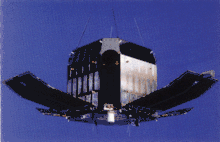Tenma
Tenma, known as ASTRO-B before launch (COSPAR 1983-011A, SATCAT 13829), was a Japanese X-ray astronomy satellite, developed by the Institute of Space and Astronautical Science. It was launched on February 20, 1983 using a M-3S rocket on the M-3S-3 mission.
For other uses, see Tenma (disambiguation).

Tenma (Japanese for "Pegasus").
Battery failure in July 1984 caused the operation to become limited, and continuing problems lead to the termination of X-ray observation in 1985. It reentered the atmosphere on January 19, 1989 (other sources, for example the NORAD catalog of satellites, say decay date was 17 December 1988[1]).
Highlights
- Discovery of the iron helium-like emission from the galactic ridge
- Iron line discovery and/or study in many LMXRB, HMXRB and AGN
- Discovery of an absorption line at 4 keV in the X1636-536 Burst spectra
See also

References
External links
| Operating |
|
|---|---|
| Planned |
|
| Proposed | |
| Retired |
|
| Hibernating (Mission completed) | |
| Lost | |
| Cancelled | |
| See also | |
| |
| Astronomical observation |
| ||||||||||||
|---|---|---|---|---|---|---|---|---|---|---|---|---|---|
| Communications, broadcasting and positioning |
| ||||||||||||
| Earth observation |
| ||||||||||||
| Engineering tests |
| ||||||||||||
| Human spaceflight |
| ||||||||||||
| Lunar and planetary exploration |
| ||||||||||||
| Private miniaturized satellites |
| ||||||||||||
| Reconnaissance |
| ||||||||||||
Kosmos 1428 | Kosmos 1429 · Kosmos 1430 · Kosmos 1431 · Kosmos 1432 · Kosmos 1433 · Kosmos 1434 · Kosmos 1435 · Kosmos 1436 | Kosmos 1437 | Unnamed | IRAS · PIX-2 | Kosmos 1438 | Sakura 2a | Kosmos 1439 | OPS 0252 · OPS 0252 SSU-1 · OPS 0252 SSU-2 · OPS 0252 SSU-3 · LIPS-2 | Kosmos 1440 | Kosmos 1441 | Tenma | Kosmos 1442 | Kosmos 1443 | Kosmos 1444 | Molniya-3 No.34 | Ekran No.18L | Kosmos 1445 | Kosmos 1446 | Molniya-1-56 | Astron | Kosmos 1447 | NOAA-8 | Kosmos 1448 | Kosmos 1449 | Molniya-1 No.68 | STS-6 (TDRS-1) | Kosmos 1450 | Gran' No.23L | Kosmos 1451 | Satcom 1R | Kosmos 1452 | OPS 2925 | Rohini RS-D2 | Kosmos 1453 | Soyuz T-8 | Kosmos 1454 | Kosmos 1455 | Kosmos 1456 | Kosmos 1457 | Kosmos 1458 | GOES 6 | Kosmos 1459 | Kosmos 1460 | Kosmos 1461 | Kosmos 1462 | Kosmos 1463 | Intelsat V F-6 | Kosmos 1464 | Kosmos 1465 | Kosmos 1466 | EXOSAT | Kosmos 1467 | Venera 15 | Venera 16 | Kosmos 1468 | OPS 6432 · OPS 6432 SSU-1 · OPS 6432 SSU-2 · OPS 6432 SSU-3 | Kosmos 1469 | ECS-1 · OSCAR-10 | STS-7 (Anik C2 · Palapa B1 · SPAS-01 · OSTA-2) | OPS 0721 · OPS 3899 | Kosmos 1470 | Soyuz T-9 | HILAT | Kosmos 1471 | Galaxy 1 | Gorizont No.17L | Prognoz 9 | Kosmos 1472 | Kosmos 1473 · Kosmos 1474 · Kosmos 1475 · Kosmos 1476 · Kosmos 1477 · Kosmos 1478 · Kosmos 1479 · Kosmos 1480 | Kosmos 1481 | Kosmos 1482 | OPS 7994 | Molniya-1 No.66 | Kosmos 1483 | Kosmos 1484 | Kosmos 1485 | Telstar 301 | OPS 7304 | Kosmos 1486 | Kosmos 1487 | Sakura 2b | Kosmos 1488 | Kosmos 1489 | Kosmos 1490 · Kosmos 1491 · Kosmos 1492 | Progress 17 | Fanhui Shi Weixing 6 | Kosmos 1493 | Gran' No.24L | STS-8 (INSAT-1B) | Molniya-3 No.32 | Kosmos 1494 | Kosmos 1495 | Kosmos 1496 | Satcom 2R | Kosmos 1497 | Kosmos 1498 | Kosmos 1499 | Galaxy-2 | Soyuz 7K-ST No. 16L | Kosmos 1500 | Ekran No.25L | Kosmos 1501 | Kosmos 1502 | Kosmos 1503 | Kosmos 1504 | Intelsat V F-7 | Progress 18 | Kosmos 1505 | Kosmos 1506 | Meteor-2 No.10 | Kosmos 1507 | Kosmos 1508 | Kosmos 1509 | OPS 1294 | Molniya-1 No.48 | Kosmos 1510 | STS-9 | Kosmos 1511 | Gorizont No.18L | Kosmos 1512 | Kosmos 1513 | Kosmos 1514 | Kosmos 1515 | Molniya-3 No.35 | Kosmos 1516 | Kosmos 1517 | Kosmos 1518 | Kosmos 1519 · Kosmos 1520 · Kosmos 1521 | |
Payloads are separated by bullets ( · ), launches by pipes ( | ). Crewed flights are indicated in bold text. Uncatalogued launch failures are listed in italics. Payloads deployed from other spacecraft are denoted in (brackets). |
This article is issued from Wikipedia. The text is licensed under Creative Commons - Attribution - Sharealike. Additional terms may apply for the media files.